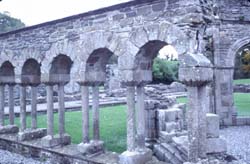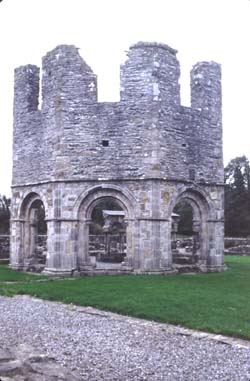 |
 |
 |
 |
 |
 |
 |
|
|
Cistercian Abbeys: MELLIFONT Name:
MELLIFONT Location: nr Drogheda County:
Louth Mellifont was the first Cistercian abbey to be founded in Ireland.
In 1139 St. Malachy O’Morgair, former archbishop of Armagh
and then Bishop of Down, set out on a pilgrimage to Rome. On
his
way he stayed in the Cistercian abbey of Clairvaux and was so impressed
with life at the monastery that he decided to become a Cistercian
monk himself. In Rome Malachy appealed to the pope to absolve him
of his priestly duties but his request was refused and so he returned
to
Ireland
to fulfil his pastoral responsibilities. On his return journey
Malachy stayed at Clairvaux for another two months, and left
four of his
companions at the abbey when he continued to Ireland. The church was consecrated in 1152. The ceremony was conducted by Gillamacliag mac Ruadhri, archbishop of Armagh and Primate of Ireland, and was attended by seventeen bishops, together with Muircheartach Ua Lochlainn, King of Ireland, Devorigilla, wife of the king of Meath and several other Irish kings. The growing prestige of the abbey was reflected by the fact that by 1170 four out of the five provincial kings had become patrons of the order. The size of the community increased rapidly and Mellifont had established six daughter houses within ten years of its foundation: Bective (1146); Boyle (1148); Monasterenanagh (1148); Baltinglass (1148); Shrule (1150); and Newry (1153). By 1170 the abbey was said to contain 100 monks and 300 lay-brothers. However, by the turn of the thirteenth century the internal standards of the abbey had been allowed to decline. The Cistercian General Chapter heard disturbing reports and, in 1216, organised a general visitation of the Irish houses. The Irish monks resented this interference from Clairvaux and when the visitors arrived at Mellifont the gates of the monastery were shut in their faces. The troubled soon spread to the other Irish Cistercian monasteries; the visitors were blocked from entry and their presence was greeted with riot. The rebellion soon became known as the ‘conspiracy of Mellifont’ and in 1217 the Cistercian General Chapter deposed Thomas, the abbot of Mellifont. In 1227 the abbot of Clairvaux sent two French monks to address the problems but they were able to remove no more than six abbots from office and they appointed the Anglo-Norman abbot of Owney to act in their stead. The Irish bitterly resented him and did all they could to hinder his progress. In 1228 a new visitor was appointed: Stephen of Lexington, abbot of Stanley, in Wiltshire. He introduced a radical programme of reform. He broke up the Mellifont affiliation and new mother houses – Margam, Buildwas, Furness, Fountains and Clairvaux – were appointed to the Irish houses. He also placed groups of Anglo-Norman monks in the Irish houses and deposed those abbots involved in the rebellion, appointing some twelve abbots himself. In 1228 Jocelin, the prior, was elected abbot of Mellifont; twelve repentant monks and sixteen lay-brothers who were involved in the conspiracy were received back; forty others, who had fled were reconciled and sent to French or English abbeys. In the same year the number in the community was fixed at fifty monks and sixty lay-brothers. The situation eventually settled down and in 1274 it was decreed that the Irish abbeys should be restored to their former parentage. Abbot John Waring, c. 1458 – 71, brought the abbey to the verge of ruin by leasing out property too cheaply. His successor, Roger Boley, did much to improve the temporal prosperity of the abbey and at the time of the Dissolution the annual income of the abbey was valued at £352, making it the second richest Cistercian house in Ireland. Abbot Richard Contour surrendered the abbey in July 1539. King Henry VIII seized the treasures of the abbey, and unfortunately th annals were either destroyed or lost at this tim. In 1540 the royal commissioners reported that the abbey church had been used as the local parish church for some time prior to the Dissolution and that much of the precinct was in a state of ruin. In 1566 the property was granted to Edward Moore, chief of the
family Drogheda, who built a fortified house within the monastery.
Several of the monks stayed on at the abbey and in 1623 the title
of abbot of Mellifont was granted to Patrick Barnewell and again
in 1648 to John Devreux. When war broke out in 1641 the Cistercians
began to disperse and in 1718 the last abbot of Mellifont was
succeeded
by a secular priest. In 1727 the property passed to Balfour of
Townly Hall and was thereafter allowed to decay. The only parts
of the
abbey to have survived are the lavabo (c. 1200), the chapter-house
(c. 1220) and the late medieval gatehouse. A series of excavations
have also revealed the foundations of the church and conventual
buildings. The octagonal lavabo is intricately decorated and is
one of the most delicate medieval buildings in Ireland. It was
not an essential building and it is thought that it was constructed
in order to enhance the prestige of the abbey within the Order.
A reconstructed section of the Romanesque
cloister arcade now stands beside the lavabo. Hundreds of carved
and moulded stones have been recovered from the site together with
thousands
of pieces
of floor
tiles. Six patterns have been recovered on the floor tiles, four
with foliage and floral motifs, the other two with animals. Although
the remains are only fragmentary they are sufficient to convey
the immense size of the monastery in its heyday. |

